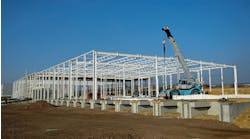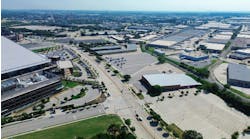The North American industrial real estate sector is undergoing a rapid transformation driven by e-commerce growth, and is forecast to grow by double digits throughout 2019 and beyond, according to the global real estate firm Cushman & Wakefield.
Over the next few years, several broad trends will influence the market, the company observes. One of these is warehouses that will get taller and be brimming with state-of-the-art technology. “Tenants will begin to test and fill multi-story warehouses, with the industry learning a tremendous amount about their functional abilities and the rent premium tenants that occupy them are willing to pay,” C&W says.
The company forecasts North American industrial real estate absorption will register a healthy 495 million square feet (msf) in 2019-2020, with 550 msf of new product delivered by year-end 2020. In the U.S., net absorption will eclipse 245 msf in 2019 with demand expected to track in the low-to-mid 200 msf range in 2020.
Expect the North American economy to keep humming along through 2020, albeit at a slightly slower pace, predicts C&W. The continent is on track to record a cyclical peak of 2.7% growth in real gross domestic product (GDP) for 2018, with a solid 2.4% forecast for 2019.
For the period 2018-2020, average GDP growth is expected to be similar to that of 2015-2017, a period during which there was 864.5 billion square feet of net absorption, vacancy rates plummeted 190 bps to a historic low of 5%, and asking rents rose 14.7%.
“Consumer and government spending, which together account for four-fifths of the North American economy, will remain bright spots,” the company believes. “In the U.S., tax reform and federal government spending will continue to juice growth in 2019, with most effects wearing off thereafter.”
Similarly, the strong reacceleration in Canada’s commodity-driven economies will fade over the next two years, C&W asserts, but with two-thirds of North American GDP derived from private consumption, it will be consumer spending that matters most. Real consumer spending is forecast to grow 2.6% in 2019 before easing to just under 2% in 2020, growth rates that are more than enough to power demand for industrial real estate at the same time rising prices and interest rates offset some of the benefits of higher wages.
The Trade War Truce
The company also sees the temporary truce in the trade war between the U.S. and China as a positive sign. In its concessions intended to foster trade negotiations, China temporarily removed an additional 25% tariff on U.S.-made cars and auto parts it had assessed in retaliation for U.S. tariffs. Chinese state-owned companies resumed purchasing U.S. soybeans, and the U.S. is postponing tariff increases that would have raised levies from 10% to 25% on $200 billion of Chinese products.
Also thriving in the current environment are our North American partners. The company expects that Canadian industrial markets will register 33.6 msf of net absorption in 2019-2020 with broad-based improvement across markets. In Mexico, the company believes Monterrey will benefit from improved trade relations while demand in Mexico City will remain strong with it absorbing 11 msf.
“The recently brokered United States-Mexico-Canada Agreement (USMCA) offers a big reason to celebrate,” C&W says. “Although the agreement must still navigate through the legislative bodies of each country for ratification, we believe that each national legislature will ratify, perhaps with a little political posturing along the way.”
The USMCA will strengthen the ties among the three countries deeply rooted in trade and investment that have given rise to significant demand for industrial real estate, the company adds. “Since NAFTA went into effect, logistics space across the three countries has increased by more than five billion square feet as interconnected North American supply chains that make production more efficient and firms more globally competitive expanded the need for industrial space.”
North American vacancies are seen remaining anchored around the 5% mark. Industrial asking rents are expected to rise 7.1% and reach a new nominal high of $6.68 (all monetary figures are in U.S. dollars) by year-end 2020, up from $6.24 in 2018. Average annual rent growth—the average of year-end growth rates from 2018 through 2020—will be greatest in the Canadian cities of Toronto, Vancouver and Montreal.
In 2018, rent growth among coastal cities was more than double that of the overall industrial market and infill-sited submarkets saw rent growth nearly three times the national rate, C&W points out. Because of the convergence of traditional import distribution and e-commerce fulfillment, port markets, like those fed by the ports of Long Beach-Los Angeles and New York-New Jersey, and infill-sited submarkets of populated inland distribution hubs, such as Dallas and Chicago, are where U.S. rent growth will be strongest.
Retail Drives Location
Among the top-performing U.S. markets in 2018 posting double-digit year-over-year rent growth were San Francisco, New Jersey, Seattle, Central Valley California, Sacramento, Boston, Memphis, Oakland/East Bay, Hampton Roads (VA), Raleigh/Durham, Los Angeles, Orange County, Austin and Atlanta.
Retailers and the third-party logistic (3PL) firms that service them will continue to covet facilities within five to seven miles of major urban markets. In addition, C&W notes that demand will continue to increase for a variety of building types, including urban depots, sortation hubs and cold storage facilities.
All of this demand also will exercise greater pressure on real estate costs. “Because large tracts of entitled land will not get any easier to find, upward pressure on infill land pricing—and the premium placed on assembled, entitled land ready for development—will continue to increase,” C&W forecasts.
Labor markets will remain tight with workers increasingly difficult to find, the company adds, pointing out that 2018 marked the eighth consecutive year that North American job growth totaled more than two million nonfarm payroll positions, bringing the cumulative job gains between 2010 and 2018 to an estimated 27.3 million payrolls, with 5.7 million of them concentrated in industrial-related industries.
In 2019 and 2020, an additional 3.6 million new jobs are anticipated to be created, with roughly 680,000 of those concentrated in industries where competition for workers will be especially fierce, C&W explains. Wages in the U.S. are expected to show year-over-year wage growth above 3%, the first time during this cycle that the figures will surpass this threshold. Wage growth for transportation/trade employment in the U.S. is even stronger—at 3.6%
“This means warehouse site selection and industrial park design—long focused on efficiently moving goods—will increasingly focus on design and development amenities that can help attract and retain workers,” it says. “It also means that when underwriting a development or engaging in site selection, a comprehensive labor study is as important as an environmental assessment in mitigating risk and ensuring that the property is aligned with the strategic business objectives of firms.”




